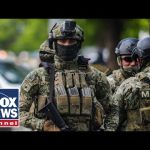The Trump administration has embarked on a bold initiative to make streets safer in the nation’s capital, and the early results are nothing short of impressive. Thanks to a comprehensive crime-fighting strategy, the streets of Washington, D.C. are becoming a little less turbulent. Over 700 arrests and the seizure of 91 illegal firearms have been reported since the announcement of the initiative known as NIRKTD Five. The results suggest that President Trump’s plan is yielding positive outcomes, and it has sparked conversations about similar efforts throughout the country.
At the heart of this operation is a unified command structure, spearheaded by the U.S. Marshal Service. With more than 20 different federal law enforcement agencies on board, including the DEA and FBI, teamwork is not just encouraged—it’s essential. The collaboration aims to bring all the necessary resources and manpower to the front lines, creating an unprecedented alliance against crime. With so many agencies working together, it’s like a superhero team, only instead of capes, they wear badges and carry intelligence tools.
But how does this grand scheme actually work? The strategy includes deploying extra law enforcement forces, along with the National Guard, as a temporary but necessary measure. They are there to make an immediate impact on crime rates, but there is a question lingering in the air: once the operation ends, will these measures continue to yield benefits? The authorities are committed to making these efforts effective in the short term while also considering the long-term implications for community safety. Reports suggest that parts of Chicago, Baltimore, and New York City might see similar deployments if success continues in D.C.
As the operation continues, the collaboration among various agencies has already begun to show fruit. By mobilizing intelligence capabilities and investigative assets, local law enforcement is leveraging federal resources to combat crime more effectively. This unified approach has resulted in a notable escalation in crime-fighting success—and it raises the question of how many lives are being protected with the removal of those illegal firearms from the streets.
One of the standout achievements mentioned was a remarkable nine consecutive days without a single murder in D.C. This milestone has not gone unnoticed by the residents, who have expressed gratitude towards law enforcement for their presence and efforts. Many citizens are publicly thanking officials, suggesting that there’s a sincere appreciation for their hard work despite a few vocal critics. Perhaps what residents of Washington are discovering is a newfound sense of security—a small but significant change in their everyday lives.
While challenges remain in the fight against crime, especially in a world complicated by local regulations like no-cash bail policies, the momentum from this operation creates hope. As federal agents and local police join forces to tackle crime head-on, there’s a rising sentiment that the streets could become a safer place for every citizen. The question now is whether this approach can be replicated in other cities struggling with similar issues. However, one thing is clear: the efforts of the Trump administration and various law enforcement agencies have sparked a movement that might just change America’s urban landscapes for the better.




